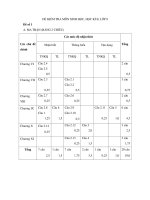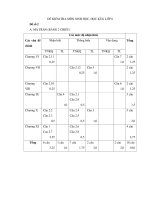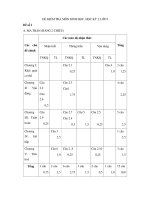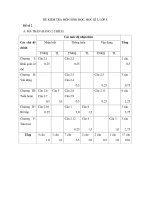Đề kiểm tra môn sinh học quốc tế - Ngôn ngữ tiếng anh ( Đề 5 )
Bạn đang xem bản rút gọn của tài liệu. Xem và tải ngay bản đầy đủ của tài liệu tại đây (1.19 MB, 8 trang )
BIOLOGY 1A MIDTERM # 1 September 24
th
, 2012 A
NAME SECTION # DISCUSSION GSI
1. Sit every other seat and sit by section number. Place all books and paper on the floor. Turn off all
phones, pagers, etc. and place them in your backpack. They cannot be visible. No calculator is
permitted.
Scantron Instructions
2. Use a #2 pencil. ERASE ALL MISTAKES COMPLETELY AND CLEARLY.
3. Write in and bubble in your name, SID, and section #. The first 8 boxes of the ID # field are for your SID.
Bubble in 00 for the bottom two boxes. Put your name on the scantron form. Under “test” write in your
GSI’s name. See below.
EXAM Instructions:
4. Print your name on THIS COVER SHEET. (otherwise, you will get a ZERO).
5. Leave your exam face up. When told to begin, check your exam to see that there are 7 numbered
pages, 51 multiple-choice questions. The exam is worth 100 pts. Each question is worth 2 points
unless otherwise indicated. You are NOT PENALIZED for guessing!
6. Read all questions & choices carefully before bubbling in your response.
7. Do not talk during the exam. The exam is closed book. You cannot use a calculator. If you have a
question, raise your hand; a GSI will help you. They will not give you the answer nor can they explain
scientific terms (e.g. binding affinity, etc.).
8. LOCATE YOUR GSI. Turn in your SCANTRON and EXAM to your GSI. YOU MUST TURN IN BOTH or
else you will get a ZERO.
9. WHEN TOLD TO STOP- YOU MUST REALLY STOP, even if you are not finished! Bubble in guesses
BEFORE THIS TIME. If you continue to write after time has been called you will risk getting a 0.
10. There is always only one best answer.
Page 1 of 7
1. Chromatin condenses to form visible chromosomes
A) during G1
B) during telophase
C) during S
D) during prophase
E) at the end of cytokinesis
2. Mark A for question 2. You have version A. It is crucial to mark the correct version of the exam.
3. Hydroxylamine is a chloroplast inhibitor that reacts specifically with the cytochrome complex. Which
of the following reactions could occur continuously in the presence of hydroxylamine and light?
A) ATP synthesis by photophosphorylation
B) NADP+ reduction
C) electron transport
D) carbon fixation
E) None of the above reactions would occur
4. A reaction is at equilibrium. You add an enzyme to the solution. You would expect the following to
occur
A) The enzyme makes the reaction more endergonic.
B) The enzyme makes the reaction more exothermic
C) The enzyme lowers the energy of activation.
D) The enzyme increases the energy of activation.
E) The enzyme makes the reaction more exergonic.
5. Polypeptides have a(n) _______ and a(n) _______ end.
A) start; stop
B) +; –
C) 5!; 3!
D) N terminus; C terminus
E) A; Ζ
6. If ΔG° = –9000 kJ/mol for the complete oxidation of a 16-carbon fatty acid that yields 100 ATP
molecules during cellular respiration, what percentage of this energy is NOT captured?
A) 33%
B) 40%
C) 66%
D) 80%
E) 99%
7. The formation of ethanol from pyruvate is an example of
A) a fermentation process that takes place in the absence of oxygen
B) additional formation of NADH + H+
C) additional formation of ATP
D) cellular respiration
E) None of the above
8. A molecule with the formula C
15
H
30
O
15
is a
A) hydrocarbon
B) lipid
C) protein
D) carbohydrate
E) nucleic acid
CHECK YOUR ANSWER FOR QUESTION 2.
Page 2 of 7
9. Mature nerve cells, which are incapable of cell division, are most likely in
A) G0
B) S phase
C) G2
D) mitosis
E) metaphase
10. Which of the following is NOT a component of the endomembrane system?
A) Rough endoplasmic reticulum
B) Smooth endoplasmic reticulum
C) Golgi apparatus
D) Lysosomes
E) Mitochondrium
11. In cyclic photophosphorylation, chlorophyll is reduced by
A) NADPH
B) plastocyanin
C) plastoquinone
D) ATP
E) hydrogen ions liberated by the splitting of a water molecule
12. Starch and glycogen are DIFFERENT in that only one of them
A) is a polymer of glucose
B) contains ribose
C) is an energy storage molecule
D) can be digested by humans
E) is made in plants
13. When NADH donates two electrons to ubiquinone during respiration, ubiquinone is
A) oxidized
B) phosphorylated
C) proteolyzed
D) hydrolyzed
E) reduced
14. Which of the following structures’ role is maintaining the position of the organelles within a cell?
A) Microtubules
B) Actin
C) Endoplasmic reticulum
D) Microfilaments
E) Intermediate filaments
15. The electric signal for a contraction passes rapidly through muscle cells by
A) tight junctions
B) desmosomes
C) integral membrane proteins
D) Plasmodesmata
E) gap junctions
16. Which of the following, if any, is NOT an argument for the endosymbiotic theory?
A) Mitochondria and chloroplasts have double membranes (outer and inner).
B) Mitochondria and chloroplasts have RNA.
C) Mitochondria and chloroplasts have DNA and ribosomes.
D) Chloroplast ribosomes synthesize proteins similar to those synthesized by bacterial ribosomes.
E) All of the above are arguments for the endosymbiotic theory
Page 3 of 7
17. Photosynthesis and Oxidative phosphorylation have the following in common
A) In eukaryotes, both processes reside in specialized organelles
B) ATP synthesis in both processes relies on the chemiosmotic mechanism
C) Both use electron transport
D) Both require light
E) A, B and C
18. The main function of cellulose, the most abundant polymer on Earth, is
A) to store hereditary information
B) as a storage compound for energy in plants
C) as a compound of lipid bilayers
D) as a component of biological membranes
E) to provide mechanical strength to plant cells
19. Trypsin and Pepsin are both enzymes that catalyze hydrolysis of proteins. But trypsin only cuts
next to lysine and pepsin cuts next to a tryptophan. Why?
A) Trypsin is a protein, and Pepsin is not
B) ΔG for the two reactions is different
C) The shape of the active site for the two enzymes is different
D) One of the reactions is exergonic, and the other is endergonic
E) Hydrolysis of lysine bonds requires water; hydrolysis of tryptophan bonds does not
20. Proteins in the plasma membrane of animals contain carbohydrates
A) on the inner side of the membrane, facing the cytoplasm
B) on the outer side of the membrane, protruding into the extracellular space
C) within the membrane
D) on both sides of the membrane
E) on neither side of the membrane
21. Why is the absorption spectrum of chlorophyll a not identical to the action spectrum of
photosynthesis?
A) Accessory pigments contribute energy to drive photosynthesis
B) Chlorophyll a absorbs both red and blue light
C) Different wavelengths of light have different energies
D) Chlorophyll a can be inactivated by absorbing a photon of light
E) Chlorophyll a reflects green light
22. In CAM plants CO
2
is captured
A) in the bundle sheath cells
B) as glucose
C) as a C3 compound in the stroma
D) as an organic acid during the night
E) Both A and D
23. The addition of the competitive inhibitor mevinolin slows the reaction HMG-CoA −> mevalonate,
which is catalyzed by the enzyme HMG-CoA reductase. The effects of mevinolin would be
overcome and the rate of the reaction increased by
A) lowering the free energy of the reaction
B) adding more mevalonate
C) adding more HMG-CoA
D) lowering the temperature of the reaction
E) adding a co-factor
Page 4 of 7
24. Which of the following represents the correct pathway for the synthesis and secretion of salivary
amylase, an enzyme secreted by the cells of the salivary gland? Not all parts of the pathway are
necessarily listed.
A) Golgi apparatus, rough ER, lysosome
B) Lysosome, Golgi apparatus, plasma membrane
C) Plasma membrane, vesicle, lysosome
D) Rough ER, cytoplasm, plasma-membrane
E) Rough ER, Golgi apparatus, vesicle, plasma-membrane
25. What is attached to the 5´-carbon of ribose in RNA?
A) Adenine
B) Ribose
C) Uracil
D) Phosphate
E) Nitrogen
26. You add pyruvate to a bacterium and the pyruvate becomes completely oxidized. Select the best
answer that describes the metabolic yield from one molecule of pyruvate. Be sure to include all
ATP from oxidative phosphorylation and substrate level phosphorylation in your answer.
A) 3 (NADH + H
+
), 1 FADH
2
, 2 CO
2
, eventually 9 ATP
B) 3 (NADPH + H
+
), 1 FADH
2
, 3 CO
2
, eventually 10 ATP
C) 3 (NADH + H
+
), 1 FADH
2
, 3 CO
2
, eventually 11.5 ATP
D) 4 (NADH + H
+
), 1 FADH
2
, 3 CO
2
, eventually 12.5 ATP
E) 4 (NADH + H
+
), 1 FADH
2
, 3 CO
2
, eventually 13.5 ATP
27. Hydrogen bonds between amino acid side chains are important in stabilizing _______ while
hydrogen bonds involving peptide bonds are important in ______.
A) tertiary structure, primary structure
B) secondary structure, tertiary structure
C) receptor proteins, structural proteins
D) primary structure, quaternary structure
E) None of the above.
28. During photorespiration, rubisco accepts _______ as a substrate.
A) water
B) NADPH
C) CO
2
D) O
2
E) ATP
29. A label on a package of ice-cream contains the word contains “hydrogenated vegetable oil.” This
indicates that during processing the number of double bonds in the oil was decreased. What is the
result of decreasing the number of double bonds?
A) The fatty acid is now a triglyceride
B) The oil now has a lower melting point.
C) The oil is now solid at room temperature.
D) There are more cis-bonds in the fatty acid chains.
E) The oil is now a derivative of carbohydrate.
30. Which of the following could be expected to INCREASE the fluidity of a cell membrane?
A) attaching oligosaccharides to the polar ends of phospholipids
B) decreasing the temperature of the environment
C) increasing the % of phospholipids with unsaturated fatty acids
D) increasing the length of fatty acid chains on phospholipids
E) increasing the % of phospholipids with saturated fatty acids
Page 5 of 7
31. In the presence of alcohol dehydrogenase, the rate of reduction of acetaldehyde to ethanol
increases as the concentration of acetaldehyde is increased. Eventually, the rate of the reaction
reaches a maximum, at which point further increases in the concentration of acetaldehyde have no
effect. Why?
A) All the alcohol dehydrogenase molecules are bound to acetaldehyde molecules
B) At high concentrations of acetaldehyde, the activation energy of the reaction increases
C) At high concentrations of acetaldehyde, the activation energy of the reaction decreases
D) The enzyme is no longer specific for acetaldehyde
E) At high concentrations of acetaldehyde, the change in free energy of the reaction decreases
32. The drug 2,4-dinitrophenol (DNP) makes the inner mitochondrial membrane leaky for protons.
What would be the immediate effect of incubating isolated mitochondria in a solution of DNP?
A) Production of ATP would stop
B) Oxygen would no longer be reduced to water
C) Mitochondria would show a burst of increased ATP synthesis
D) The electron transport chain would stop
E) Mitochondria would switch from fermentation to glycolysis
33. Which of the following pairs of polynucleotides could form a short stretch of normal properly based
DNA?
A) 5’-CGAT-3’ with 5’-GGTA-3’
B) 5’-TAAT-3’ with 5’-ATTG-3’
C) 5’-GGCC-3’ with 5’-AATT-3’
D) 5’-ATCG-3’ with 5’-CGAT-3’
E) 5’-ATAT-3’ with 5’-TATA-3’
34. Allosteric inhibitors act by
A) decreasing the number of enzyme molecules
B) increasing the number of enzyme molecules
C) binding to the active site
D) increasing the amount of substrate
E) decreasing the amount of the active form of the enzyme
35. When white light strikes an orange pigment, orange light is
A) reduced
B) absorbed
C) oxidized
D) scattered or transmitted
E) used to synthesize ATP
36. The hydrophilic regions of a membrane protein are most likely to be found
A) only in brain cell membranes
B) exposed on the surface of the membrane
C) associated with the fatty acid region of the lipids
D) in the interior of the membrane
E) either on the surface or inserted into the interior of the membrane
37. During an experiment, cultured human cells were treated with an inhibitor of complex IV in the
electron transport chain. What do you expect to happen to the pH (in the matrix space) and ATP
production capacity of mitochondria in these cells compared to untreated cells?
A) pH increases, ATP synthesis increases
B) pH increases, ATP synthesis decreases
C) pH and ATP synthesis are unchanged
D) pH decreases, ATP synthesis increases
E) pH decreases, ATP synthesis decreases
Page 6 of 7
38. Osmosis moves water from a _______ to a _______.
A) high concentration of solutes; low concentration of solutes
B) low concentration of solutes; high concentration of solutes
C) low water concentration; high water concentration
D) 1M glucose solution: 0.5 M NaCl solution
E) None of the above.
39. The energy to hydrolyze water comes from
A) oxidized chlorophyll
B) glycolysis
C) the proton gradient
D) ATP
E) NADPH + H
+
40. A prokaryotic cell does not have a _______ or _______.
A) nucleus; DNA
B) nucleus; ribosomes
C) nucleus; RNA
D) cell wall; nucleus
E) nucleus; endoplasmic reticulum
41. Which reaction below represents an anabolic process?
A) C
6
H
12
O
6
+ 6O
2
→ 6CO
2
+ 6H
2
O
B) sucrose → fructose + glucose
C) protein → amino acids
D) nucleotides, → RNA
E) None of the above
42. Oxygen is produced by organisms through
A) Glycolysis
B) Calvin cycle
C) Oxidative phosphorylation
D) Fermentation reaction
E) None of the above
43. Which of the following statements about the exergonic hydrolysis of cellobiose to glucose is true?
A) The reaction releases free energy
B) The reaction requires a net input of energy
C) The free energy of glucose is larger than the free energy of cellobiose
D) The reaction is not spontaneous
E) At equilibrium, the concentration of cellobiose is higher than the concentration of glucose
44. In C
4
plants, the four-carbon compound that is synthesized in the mesophyll cells is used to
A) split water
B) combine with CO
2
to produce glucose
C) carry CO
2
to the bundle sheath cells
D) drive the synthesis of ATP
E) close the stomata.
45. Ribosomes are NOT found in
A) mitochondria.
B) chloroplasts.
C) the rough endoplasmic reticulum.
D) prokaryotic cells.
E) Lysosome. EXAM CONTINUES ON THE NEXT PAGE
EXAM CONTINUES
ON THE NEXT PAGE.
Page 7 of 7
46. During prokaryotic cell division, two chromosomes separate from each other and distribute into the
daughter cells by
A) attachment to actin filaments
B) a mitotic spindle
C) repellent forces
D) attachment to separating membrane regions
E) All of the above
47. Which of the following is an example of an exergonic reaction?
A) Macromolecule formation
B) Cellular respiration
C) Phagocytosis
D) Receptor-mediated endocytosis
E) The Na
+
–K
+
pump
48. Which of the following biological groups is dependent on photosynthesis for its survival?
A) Humans
B) Fungi
C) Insects
D) Plants
E) All of the above
49. The initiation of the S phase and the M phase of the cell cycle depends on a pair of molecules
called _______ and _______.
A) actin; myosin
B) Cyclin; CDKs
C) ligand; receptor
D) Cyclin; Microtubules
E) ATP; NADPH
+
50. Three amino acids are shown (I II, III). Select the best statement that describes the hydrophobicity
of these R groups.
A) Only I is hydrophobic
B) Only II is hydrophobic
C) Only III is hydrophobic
D) Both I and II are hydrophobic
E) All three (I, II and III) are hydrophobic
Amino Acid I Amino Acid II Amino Acid III
51. One difference between plant and animal cells is that
A) plant cells lack a cytoskeleton
B) only animal cells have mitochondria
C) only animal cells contain centrioles
D) plant cells have a cell wall, whereas animal cells have a plasma membrane
E) only animal cells have peroxisomes END OF THE EXAM









